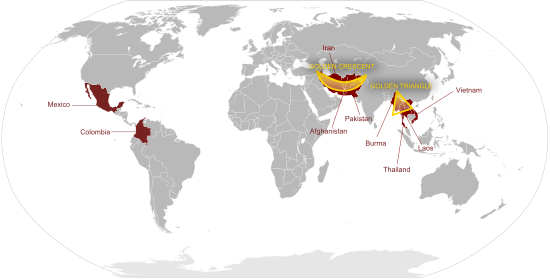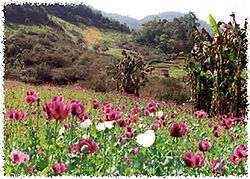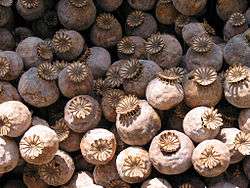Opium production in Myanmar
Opium production in Myanmar has historically been a major contributor to the country's gross domestic product (GDP). Myanmar is the world's second largest producer of opium after Afghanistan, producing some 25% of the world's opium, and forms part of the Golden Triangle. The opium industry was a monopoly during colonial times and has since been illegally operated by corrupt officials in the Burmese military and rebel fighters,[1] primarily as the basis for heroin manufacture.

Production is mainly concentrated in the Shan and Kachin states. Due to poverty, opium production is attractive to impoverished farmers as the financial return from poppy is 17 times more than that of rice. The yield during 2012 was 690 tons, valued at US $359 million.[2]
Economic specialists indicate that recent trends in growth have the potential to increase the gap between the rich and the poor in the country, empowering criminal rackets at the expense of democracy.
History
Opium has been present in Myanmar (formerly known as Burma) since as early as the 1750s, during which the Kongbaug Dynasty was in power.[3] The United States provided economic aid to the country then known as Burma in 1948 to reduce the opium trade. Between 1974–78, Burma received eighteen helicopters from the US for opium caravan interception.[4] In 1990, Myanmar was producing more than half of the world's opium. The percentage dropped to one third by 1998. In 1999, the country reported a goal to become opium-free by 2014.[5]
According to the United Nations Office on Drugs and Crime, it is estimated that in 2005 there was some 167 square miles (430 km2) dedicated to opium cultivation in Myanmar. According to a United Nations report, opium production has increased every year since then and as of 2012 had increased to around 510 square kilometres (200 sq mi).[1] There is a crackdown on the trade and since 1998 production in Myanmar has fallen overall by some 83% as of 2012; and in 2012 alone some 240 square kilometres (93 sq mi) of poppy fields had been eradicated, but the general trend is a steady increase in production according to recent surveys.[1]
As of 2012, some 300,000 households in Myanmar were involved in the industry.[6] As of 2012, China had over 1.1 million registered drug addicts and accounted for over 70 per cent of all heroin consumption in the Asia-Pacific region.[7] In 2012, Myanmar produced 690 metric tons with a value of approximately $359 million.[5]
Myanmar is also one of three countries of the golden "triangle" with Thailand and Laos forming the other two arms, where opium production accounted for about 50% of the world's consumption in 1990 but was reduced to about 33% by 1998.[2] Myanmar part of this triangle is reported to be a lawless region.[8]
Production


Myanmar is the world's second largest producer of opium after Afghanistan, producing some 25% of the world's opium.[1][6] In the past, though, it was "the world's unrivaled leader in opiate production".[9] Production is mainly concentrated in the Shan and Kachin states.[1] China is the most important market for Burmese opium, due to an increase in heroin addiction in the country.[7]
On an annual rate, production of opium in the country was estimated to be some 150 tonnes (150 long tons; 170 short tons), according to the Central Intelligence Agency (CIA) in 1956.[10] However, in 2012 it was a record 690 metric tons with estimated value of about US $359 million,[2] due to increased demand during last six years in succession, in Asia.[11]
In just one year between 2011 and 2012 the land area brought under opium crop has shot up from 40,000 ha to 51,000 ha, a 17% increase.[2][11]
Drug movement
Prior to the 1980s, heroin was typically transported from Myanmar to Thailand, before being trafficked by sea to Hong Kong, which was and still remains the major transit point at which heroin enters the international market. Now, drug trafficking has circumvented to southern China (from Yunnan, Guizhou, Guangxi, Guangdong) because of a growing market for drugs in China, before reaching Hong Kong.[12]
The Burmese economy and opium
The prominence of major drug traffickers have allowed them to penetrate other sectors of the Burmese economy, including the banking, airline, hotel and infrastructure industries.[13] Their investment in infrastructure have allowed them to make more profits, facilitate drug trafficking and money laundering.[14]
Due to the ongoing, rural-based insurgencies within Myanmar, many farmers have little alternative but to engage in opium production, which is used to make heroin.[1] Most of the money earned from opium sales go into the drug barons' pockets; the amount left is used to sustain the livelihood of the farmers.[15] Economic specialists indicate that recent trends in growth have the potential to increase the gap between the rich and the poor in the country, empowering criminal rackets at the expense of democracy.[6]
Eradication programme
With the establishment of the democratic government after the rule of a military junta, there is hope that opium eradication would be a serious public policy. The new government has taken steps to reform the system but the ground situation is otherwise as there is an upsurge in its production and this is attributed in a report by the UN as due to "the resurgence in opium production in Southeast Asia is the demand for opiates, both locally and in the region in general".[11]
Government reports claim that in 2012, a fourfold increase of elimination of poppy fields has been effected amounting to 24,000 hectares of poppy fields.[1] According to the U.N. Office on Drugs and Crime (UNODC) land poppy cultivation registered an increase of 17 percent, the highest increase in eight years.[8]
References
- "UN report: Opium cultivation rising in Burma". BBC. 31 October 2012. Retrieved 10 June 2013.
- "UN Says Burmese Opium Production Rising". Irrwaddy organization. 31 October 2012.
- James, Helen (2012). Security and Sustainable Development in Myanmar/Burma. Routledge. pp. 94–. ISBN 9781134253937.
- Chouvy, Pierre-Arnaud (2009). Opium: Uncovering the Politics of the Poppy. Harvard University Press. pp. 109–. ISBN 978-0-674-05134-8.
- Pitman, Todd (October 31, 2012). "Opium Production In Myanmar On Rise, Says UN". Retrieved 11 June 2013.
- "The Spike In Myanmar's Opium Production Could Destabilize All Of Asia". Business Insider. 1 November 2012. Retrieved 10 June 2013.
- "Opium cultivation increases for sixth year in Burma, according to UN report". The Telegraph. 31 October 2012. Retrieved 10 June 2013.
- "Myanmar opium output rises despite eradication effort". Reuters.com. 31 October 2012. Retrieved 13 June 2013.
- Rotberg, Robert I. (1998). Burma: Prospects for a Democratic Future. Brookings Institution Press. pp. 186–. ISBN 9780815791690.
- Derks, Hans (2012). History of the Opium Problem: The Assault on the East, Ca. 1600 – 1950. BRILL. pp. 428–. ISBN 9789004221581.
- "Opium Production In Myanmar On Rise, Says UN". Huffington Post. 31 October 2012. Retrieved 13 June 2013.
- Chin, Ko-lin; Sheldon X. Zhang (April 2007). "The Chinese Connection: Cross-border Drug Trafficking between Myanmar and China" (PDF). U.S. Department of Justice: 98. Cite journal requires
|journal=(help) - Chin, Ko-lin (2009). The Golden Triangle: inside Southeast Asia's drug trade. Cornell University Press. pp. 239–240. ISBN 978-0-8014-7521-4.
- Lyman, Michael D.; Gary W. Potter (14 October 2010). Drugs in Society: Causes, Concepts and Control. Elsevier. ISBN 978-1-4377-4450-7.
- South, Ashley (2008). Ethnic Politics in Burma: States of Conflict. Routledge. pp. 145–. ISBN 9780203895191.